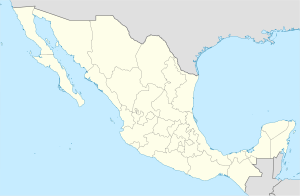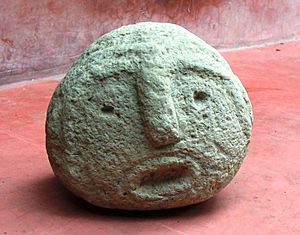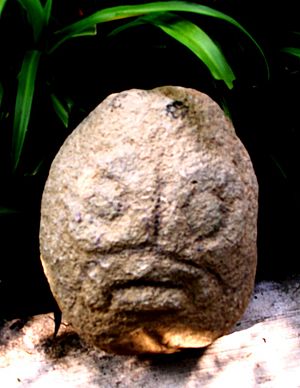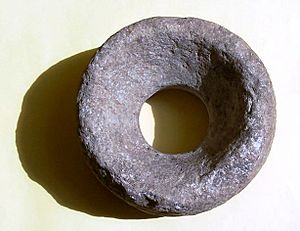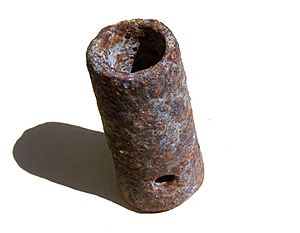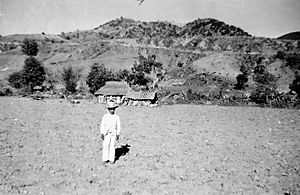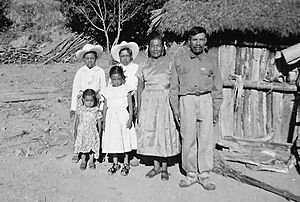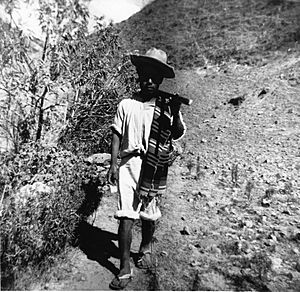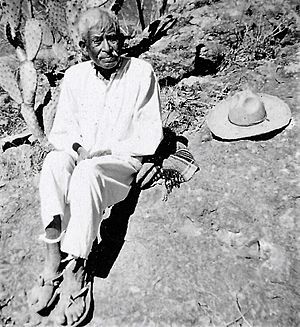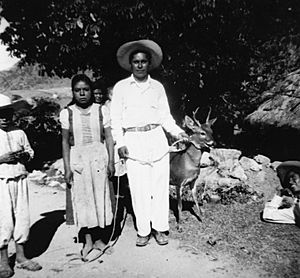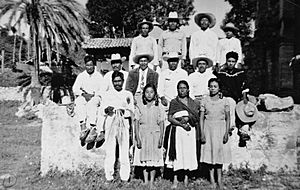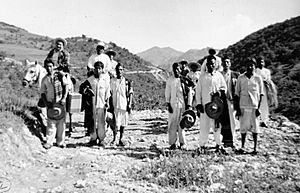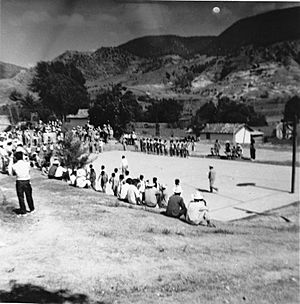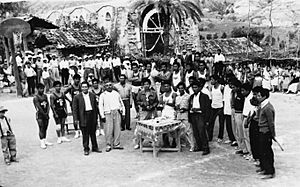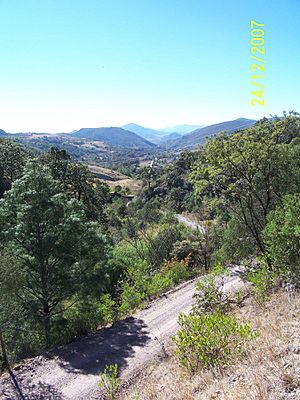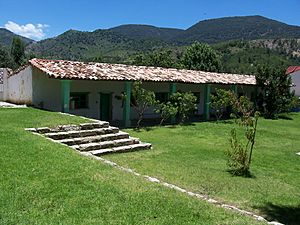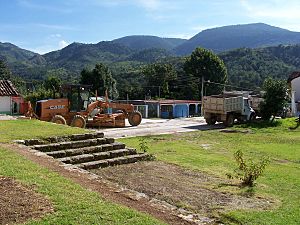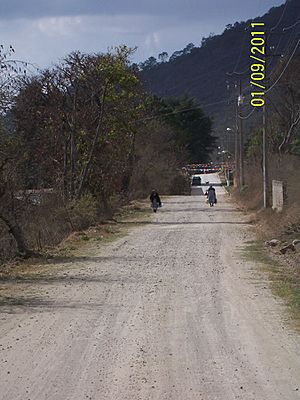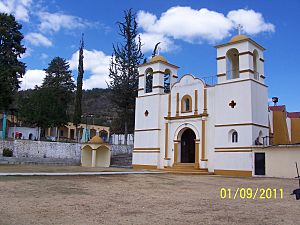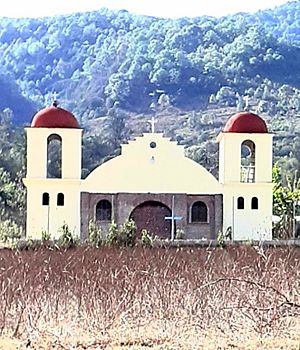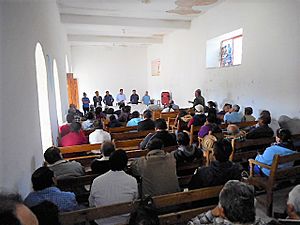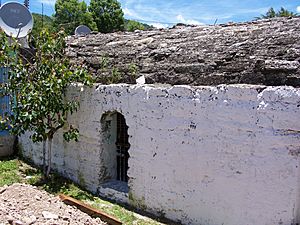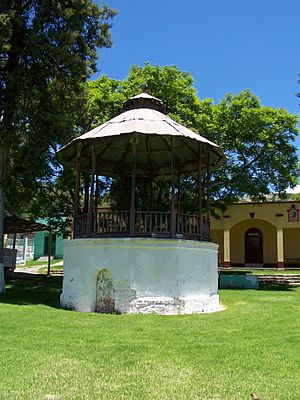San Juan Achiutla facts for kids
Quick facts for kids
San Juan Achiutla
|
|
|---|---|
|
Municipality and town
|
|
| Country | |
| State | Oaxaca |
| Area | |
| • Total | 49.76 km2 (19.21 sq mi) |
| Population
(2005)
|
|
| • Total | 401 |
| Time zone | UTC-6 (Central Standard Time) |
| • Summer (DST) | UTC-5 (Central Daylight Time) |
San Juan Achiutla is a town and municipality in Oaxaca, located in southwestern Mexico. It covers an area of about 49.76 square kilometers. The town is nestled in a mountain range, surrounded by hills like Negro, Yucuquise, Cuate, and Totolote.
The Los Sabinos river flows through the area, and there's a dam called Cahuayande. The weather here is mild. San Juan Achiutla is part of the Mixteca Alta, a high-altitude region within the larger Mixteca area. This place was very important even before the Spanish arrived. In 2005, the municipality had a total population of 401 people.
Contents
The Mixteca Region
In 1906, a French scientist named Leon Diguet wrote about the Mixteca region. He explained that this mountainous area was home to the Mixtec Indians. After the Spanish arrived, it became known as La Mixteca province.
The name Mixtecapan comes from the Nahuatl word Mixtlan, which means "cloudy or foggy land." This name was probably given because the high mountains of the Mixteca Alta often have cool, cloudy weather. This region includes parts of the modern-day states of Oaxaca, Puebla, and Guerrero.
The original Mixtec name for their land is not known. However, a missionary named Father Antonio de los Reyes, who lived there around 1593, said that the Zapotecs (a neighboring group) called the Mixtecs Mixtoquijxi, meaning "wild cats." This might have been a joke about how tough the places were where the Mixtecs chose to live.
Achiutla's History
Leon Diguet also studied the history of Achiutla. He believed that two places were key to the Mixtec people settling down: Apoala and Achiutla. These places grew into important cities, even though today they are smaller towns.
Achiutla, also known as Achioztlan, is now represented by two towns: San Juan Achiutla and San Miguel Achiutla. In 1906, their combined population was about 1,800 people. The old city of Achiutla was north of San Miguel, on a plateau where a church now stands. Before the Spanish conquest, Achiutla might have had as many as 14,000 inhabitants. However, an epidemic greatly reduced its population.
Achiutla was a very important spiritual center in the High Mixteca region. It was home to the Taysacca, or religious leader. The temple there was famous, and people came from all over to worship a god believed to be a form of Quetzalcoatl. This god was represented by a large emerald with a bird and a snake carved into it. The Spanish were amazed by this jewel, but missionaries later destroyed it.
Near the old city, there is a cave that looks like a tunnel. It was thought to connect to San Juan, allowing people to travel between the towns during wars. The Nahuatl name Achiutla might come from this cave, meaning "place of the frequented cave." Another idea is that it means "site where roads ooze water."
The Mixtec name for the city was Sundecu or Sundico, meaning "village made into dust." This name might have been given because the sacred emerald was ground into dust by missionaries. Achiutla's important location and religious significance likely made people see it as the origin place of the Mixtec nation.
Sacred Landscapes and Ancient Beliefs
Jansen and Pérez Jiménez wrote about Achiutla in their book Paisajes Sagrados. They mention the Codex Añute (Selden), which shows a princess traveling underground from a rock opening near a river. This place was where the "Heart of the Rain People" jewel was honored. This is likely the cave Ñuu Ndecu (Achiutla).
Manuel A. Hermann Lejarazu explains that Ñuu Ndecu (Achiutla), also called "Burning City," was the spiritual heart of the High Mixteca. It was home to a "Great Temple" where leaders sought advice for peace and war. People from far away came to ask for favors and guidance.
The Mixtec origin story tells of the Sun and Venus gods throwing darts from the sky. One dart fertilized the Earth, leading to the birth of the first ancestor. The granddaughter of this first lord married a prince who was born from a large tree in the "City on Flames," Ñuu Ndecu (Achiutla).
The main temple was on the highest mountain. The high priest worshipped a sacred item called "The People's Heart." This was an ancient jade stone, shaped like a bird and a coiled snake. It represented the divine power of Mesoamerica, similar to Quetzalcoatl.
The historian Francisco Burgoa described "The People's Heart" in 1674, long after it was destroyed. He said it was a transparent emerald, carved with a bird and a snake, and it seemed to glow from within. It was a very old and highly respected jewel.
The Aztecs conquered Achiutla in the 15th century and burned its main temple in 1462. This event is why one of the meanings of Ñuu Nducu is "burned town" or "city in flames."
Traces of the Colonial Period
When Hernán Cortés arrived in Mexico, the Aztec ruler Moctezuma II sent gifts to the "People's Heart" deity in Achiutla. He wanted to know what fate awaited his people. The Oracle gave a sad message: "Moctezuma's lordship is over." This news reached Ñuu Ndecu when Lord 2 Vulture and Lady 13 House ruled.
From 1522 to 1528, Achiutla was unfairly controlled by Martín Vázquez, who was later punished for mistreating the local chiefs. In 1528, Achiutla became part of Francisco Maldonado's encomienda (a Spanish system of forced labor). The town gave him 48 gold dust "tejuelos." Later, in 1550, his wife, Doña Isabel Roxas, took over the encomienda.
In 1555, the viceroy ordered that the Santo Domingo religious order be allowed into Achiutla. The Dominicans finally settled in Ñuu Ndecu in 1557 and built a "doctrine-convent."
One of the Dominican priests, Fray Benito Hernández, wrote a Christian catechism in Mixtec. He is known for converting the Mixtecs of Ñuu Ndecu. However, the people continued their old religious practices secretly in nearby caves and hills, worshipping "The People's Heart." Fray Benito found out about this sacred image and went to the summit where it was kept. He destroyed the ceremonial center, which contained "an immensity of several figures of idols." He also had "The People's Heart" ground into powder and scattered it in front of a large crowd. This happened shortly after 1557.
In 1584, the colonial government issued land titles for San Juan Achiutla. In 1748, communal titles were issued.
The San Juan Evangelista Church in San Juan Achiutla has an oil painting from this period. It dates to 1749 and shows the Holy Trinity, an Archangel, Saint Dominic, Saint Francis of Assisi, and a scene of purgatory. Below, a solemn mass is depicted. This painting suggests that some people in the town had enough money to commission art and hold important religious ceremonies.
Modern Times
San Juan Achiutla does not have a municipal archive, so it's hard to trace its history through official documents. Much of its recent history is known through oral tradition and personal accounts.
In 2010, a book of memoirs by Raúl Ruiz Bautista, Camino por la Mixteca, helped fill in some gaps in San Juan Achiutla's history. This book covers events from after the Mexican Revolution into the 21st century. The history of San Juan and the construction of the Ixtapa-Tlacotepec road are closely linked.
Key Events in the 20th Century
- 1920s: Many people from San Juan Achiutla migrated to Veracruz State to find work in factories or on farms. They often returned for the town's feast on December 27.
- 1929: The first primary school was built, with Rutilio Ruiz Hernández as the teacher.
- 1935: The elementary school became the Rural Federal School Francisco I. Madero.
- 1936: Eliseo Ruiz López was the first person from San Juan Achiutla to leave to study at a rural teacher's college.
- 1942: The municipality of San Juan Achiutla was officially established. Also, the community's communal land was legally titled.
- 1947: The Municipal Palace was built.
- 1949: Raúl Ruiz Bautista launched a plan to build the San Felipe Ixtapa - San Agustín Tlacotepec road to help the region. Rutilio Ruiz Hernández became the leader of the road construction.
- 1951: The Regional Committee of Indigenous Youth and Communities was founded in San Juan Achiutla. Construction of the road began in October.
- 1953: The Vanguardia Progresista de San Juan Achiutla en el Distrito Federal was formed by people from San Juan living in Mexico City to support their hometown.
- 1954: Alfonso Caso, director of the National Indigenous Institute, visited and supported the road project.
- 1956: Telephone service was connected to San Juan Achiutla. Workers on the road began to receive a basic wage after working for free for nearly five years.
- 1958: A Post Office and telephone service were built. The first basketball court was also built with support from the Vanguardia Progresista.
- 1961: Construction of the potable water system began. The first electricity generator was installed.
- 1963: The Ixtapa-Tlacotepec road was officially opened after 15 years of effort. The drinking water system and electricity generator were also inaugurated.
- 1965: A school census showed 285 students in primary school.
- 1969: Construction of the electric network began.
- 1971: The Las Lajas dam was built for irrigation.
- 1979: A rural clinic was built.
- 1980: The Federal Secondary School Eng. Alfonso Martínez Berges was established.
- 1984: The first public telephone service (Telmex) was installed.
- 1988-1989: The three domes of the Church of St. John the Evangelist were built.
- 1993: The Mixteco Towns Union was created, aiming to expand and pave the Ixtapa-Tlacotepec road.
- 2004: The IEBO (high school) campus 126 "Achiutla" was established to serve several towns.
- 2008: Public internet services became available in San Juan Achiutla.
- 2010s: Streets were paved and sidewalks built. Old classrooms at the elementary school were demolished, which was seen as a loss of cultural heritage. In 2011, the total number of students in San Juan Achiutla was 142, much lower than in 1965. The Ixtapa-Tlacotepec road, despite being led by San Juan Achiutla, remained unpaved in 2011.
Cultural and Historical Heritage
San Juan Achiutla has many important cultural and historical sites:
- The Achiutla Pre-Hispanic site and the San Miguel Arcángel Dominican Convent.
- The St. John the Evangelist Church.
- A collection of 18th-century oil paintings inside the church.
- "El chorrito" drinking water box.
- The prison and nearby municipal buildings.
- The Municipal Palace.
- The kiosk in the front garden at City Hall.
- The monument to the flag.
- The book Camino por la Mixteca by Raúl Ruiz Bautista, published in 2010, is also considered a valuable part of its heritage.
Cultural Traditions
The Mixtec culture, which San Juan Achiutla is part of, is a vibrant and living culture. Ronald Spores notes that Mixtec people have kept their identity and customs for over 3,000 years. They have adapted to new circumstances, even moving to other parts of Mexico and North America.
The Mixtec region covers a large area of about 40,000 square kilometers. It includes the High Mixteca (where San Juan Achiutla is), the Low Mixteca, and the Mixteca de la Costa. Even with many changes over centuries, Mixtec culture continues to thrive. Many Mixtec people have left their homeland, but their hearts and feelings remain connected to their traditions.
San Juan Achiutla preserves several ancient cultural traditions:
- The tequio: This is required community work that helps keep the town clean and healthy.
- The gueza (or guelaguetza): This is a system of mutual support, where neighbors and relatives help each other with supplies or money for celebrations like weddings, baptisms, funerals, or mayordomías. It's a promise to help back when needed.
- The mayordomía: This is when an individual takes responsibility for organizing the annual Patron Saint San Juan festival. It can be a big financial commitment.
- The posadas: These are festivities held for eight days before Christmas. They involve processions, prayers, and sharing food, drinks, gifts, and breaking piñatas.
- The pastorela: A Christmas play performed by volunteer actors from the town.
- The danza del guajolote (Turkey dance): The outgoing mayordomo gives a turkey as a gift to the new mayordomo through dancers.
- Música de viento (wind music band): This band plays music for both religious and social events.
- The pre-Hispanic legend of El flechador del sol (The Sun Archer), which mentions Achiutla.
Images for kids
See also
 In Spanish: San Juan Achiutla para niños
In Spanish: San Juan Achiutla para niños


